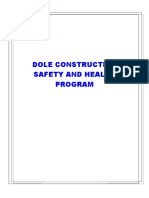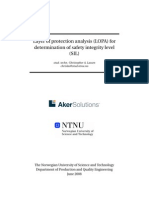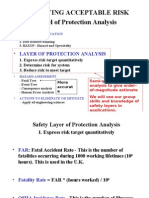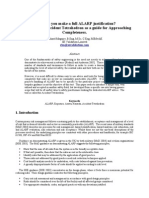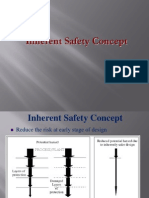899 Howto LOPA
899 Howto LOPA
Uploaded by
kumar_chemicalCopyright:
Available Formats
899 Howto LOPA
899 Howto LOPA
Uploaded by
kumar_chemicalOriginal Description:
Original Title
Copyright
Available Formats
Share this document
Did you find this document useful?
Is this content inappropriate?
Copyright:
Available Formats
899 Howto LOPA
899 Howto LOPA
Uploaded by
kumar_chemicalCopyright:
Available Formats
HOW to lopa
Layers of protection know your onions
richard gowland
PROCESS SAFETY SPECIALIST; FORMER TECHNICAL DIRECTOR OF EUROPEAN SAFETY CENTRE, EPSC
AYER of Protection Analysis (LOPA) has become a popular
typical workflow
and convenient method for simplified risk assessment and as an important part of the life cycle of safety
instrumented systems which are covered by IEC 61511 (see
START
Figure 1, IEC 61511 part 3). It offers assistance in answering
the questions: is an operating system optimised for safety or
the environment? Does the operating system appear to be
under-protected when predictable hazards are considered?
When I have a defined frequency target based on the severity of
an unmitigated hazard, does my system ensure that this target
CONCEPTUAL
PROCESS
DESIGN
DEVELOP
SAFETY
REQUIREMENT
SPECIFICATION
PERFORM
PROCESS
HAZARD
ANALYSIS
& RISK
ASSESSMENT
PERFORM SIS
CONCEPTUAL
DESIGN &
VERIFY IT
MEETS
THE SRS
APPLY NON-SIS
PROTECTION
LAYERS TO
PREVENT
IDENTIFIED
HAZARDS OR
REDUCE RISK
PERFORM SIS
DETAIL DESIGN
is met? And if not: what is the scale of the deficiency and how
ESTABLISH
OPERATION &
MAINTENANCE
PROCEDURES
might it be rectified?
The layer of protection concept is often described using
the LOPA onion (see over). It shows that an operating facility
is controlled for its designed purpose and is surrounded by
layers which are intended to prevent harm to persons or the
environment. The Center for Chemical Process Safety produced
PRE-STARTUP
SAFETY REVIEW
(ASSESSMENT)
an excellent guide to LOPA in 2001 (Layer of Protection Analysis
Simplified Process Risk Assessment, ISBN 0816908117, available from
IChemE). When LOPA is itself mapped, we get something like
the diagram from appendix 2 of the Process Safety Leadership
Group Final Report on the Buncefield Accident (2009) Safety and
Environmental Standards for Fuel Storage Sites (see Figure 2).
The whole study starts from an understanding of hazardous
scenarios developed before LOPA is attempted.
Obviously in an operating facility there may be several
significant scenarios which need study. LOPA is a method
which is based on assessing single scenarios. This means that
several LOPA studies would be required for a typical unit. An
example is the case of a gasoline storage facility such as the
NO
IS SIS
REQUIRED?
tank which overflowed at Buncefield in 2005. The two immediately obvious scenarios would be for fire and explosion. This
would mean that a LOPA study would be done for each. In
YES
turn, each of these studies would need to address the various
DEFINE
TARGET SIL
initiating events which could start a train of events leading to
SIS
INSTALLATION,
COMMISSIONING &
PRE-STARTUP
ACCEPTANCE
TEST
SIS STARTUP,
OPERATION,
MAINTENANCE,
PERIODIC
FUNCTIONAL
TESTING
MODIFY
OR DECOMMISSION
SIS?
MODIFY
SIS
DECOMMISSIONING
an overflow.
examine identified scenarios
The obvious starting point in a LOPA study will be to examine
Figure 1: iec 61511 life cycle. LOPA fits well from the process
hazard analysis step through to the question Is SIS required?
each identified scenario for its potential severity. This
MAY 2016 | The Chemical Engineer | page 49
How to LOPA
COMM
UNIT Y EMERGENCY RESPON
IP
SE
ERGENCY RESPON
PL A N T E M
SE
P R OT E C T I O N E G R E L I E F D
E VIC
S I CA L
ES
PH Y
MENTED SYSTEM PRE V
EN T
ST RU
N
I
ATI
Y
T
E
VE
F
R ATOR INTERVE
AC
SA
NTI
S /O P E
TIO
ON
ARM
L
A
(
/
N
via
S
PC
S
B
)
(
O
P
M
ER A
E
IP
B
T
S
R
P
Y
TIN
T
CS
LS
G
O
D
?
R
)
IS
NT
C
O
/S U
PERVISION
B A S I C PR O C
NE
ES
LI
PLANT
DESIGN
INTEGRITY
the LOPA ONION: Depicting the layers of protection normally arranged to control the hazards on an operational facility
would ideally proceed or emanate from a hazard identifi-
People (R2P2), The Buncefield Final Report appendix 2 (Dec
cation process such as HAZOP or HAZID, where deviations,
2009), and the Chemical and Downstream Oil Industry Forum
causes, consequences and safeguards will have been identi-
(CDOIF) guidance on environmental hazards.
fied. The consequences at this stage may or may not have been
It is not the purpose of this article to tell the reader what
sufficiently studied to allow a proper estimation of severity to
to do here. It requires logical thought and effort to choose a
be established. It is important to gain agreement from the study
target frequency. If too high a frequency target is chosen (eg for
team on this severity, usually in terms of harm to persons or to
a single fatality), it is unlikely to pass the ALARP test which
the environment. In some cases, this might be quite a simple
will be needed at the end. It may also fail to meet a regula-
step in the sense that the identified consequence is most likely
tors expectations. Again, reference to the publication Safety
to affect a limited number of persons. This might be true for a
and Environmental Standards for Fuel Storage Sites, appendix 2 is
pool fire, but is much less clear when an explosion is considered.
very helpful.
A conservative approach is therefore vital.
Once the consequence has been defined, it needs
to be assessed for a target frequency which is
related to internal guidance from the company
and that of the competent authorities
initiating events
Having established a target frequency, the first (of perhaps
several) initiating events needs to be considered. This will
likely come from the cause section of the HAZOP/HAZID. The
most convenient first initiating event will probably be a failure
in a process control or indication such as a level, pressure,
Once the consequence has been defined, it needs to be assessed
or temperature control loop. This needs to have a failure
for a target frequency which is related to internal guidance
frequency assigned to it. The source of this information is
from the company and that of the competent authorities (eg
ideally from the users own documented failure and main-
the Health and Safety Executive of Great Britain, and the UKs
tenance records. The equipment manufacturer can provide
Environment Agency). This guidance is related to the concepts
typical results. Failing that, there are databases available
of Broadly Acceptable and ALARP frequencies described in
which indicate typical ranges. Whichever is chosen, justifi-
the HSEs approach to risk described in Reducing Risks, Protecting
cation will be required. Clause 8.2.2 in IEC 61511 specifies the
MAY 2016 | The Chemical Engineer | page 50
How to LOPA
lowest frequency allowed for instrumented systems typically
used in basic process control systems, but it is wrong to assume
SELECT TANK FOR STUDY
that this frequency is the default value. Effort is required for
the LOPA study to justify the number used in the environment
and circumstances which apply.
If a human error is chosen as an initiating event, it needs
to be properly assessed via a task analysis and a probability of
DECIDE WHETHER CONSIDERING HARM TO
PEOPLE OR HARM TO ENVIRONMENT AND
DETERMINE THE SEVERITY OF THE HARM FOR
THE SCENARIO BEING ASSESSED
SEE
SECTIONS
3&4
SYSTEMATICALLY IDENTIFY EVENTS AND
RELATED ENABLING EVENTS/CONDITIONS
THAT COULD (IF ALL OTHER MEASURES FAIL)
LEAD TO THE HARM BEING CONSIDERED AND
DOCUMENT THE SCENARIOS FOR EACH
SEE
SECTION 5
FOR EACH INITIATING EVENT LIST THOSE RISKREDUCING MEASURES (PREVENTION AND
MITIGATION PROTECTION LAYERS,
CONDITIONAL MODIFIERS ETC) THAT RELATE
TO THAT INITIATING EVENT, INCLUDING ANY
EXISITING OR PROPOSED HIGH LEVEL SAFETY
INSTRUMENTED FUNCTION
SEE
SECTIONS
6&7
error established. This should take account of the complexity
of the task and the error-producing factors such as lack of
training, unfamiliarity, stress, time pressure. Techniques such
as human error assessment and reduction technique (HEART)
or technique for human error rate prediction (THERP) can
be used for this. This probability is then combined with the
number of times the task is carried out to arrive at a frequency.
enabling events
The next step will be to consider the enabling events and
conditional modifiers which might be relevant.
A typical enabling event can be for example, the proportion
CONDUCT LOPA TO CALCULATE
THE FREQUENCY OF HARM FROM ALL
INITIATING EVENTS
of the year when a hazard is present. This is common in batch
processes in which a reaction is taking place for less than 100%
of the time, or a tanker-unloading operation. It may also be
REPEAT FOR ALL RELEVANT
INITIATING EVENTS
relevant to consider for injury cases the proportion of time
when persons could be in range of the effect of a hazardous
event during his or her work pattern. This needs to be handled
SUM THE FREQUENCY OF HARM FROM
ALL INITIATING EVENTS
with care since management of change may not prevent
subtle but significant changes with time. Furthermore, the
environment is always present and potentially exposed.
Examples of conditional modifiers include probability
COMPARE THIS TOTAL WITH TARGET
FREQUENCY FOR THE LEVEL OF SEVERITY
of ignition if a fire or explosion is considered. Furthermore,
SEE
SECTION 4
it might be necessary to consider that if an ignition takes
place, the result could be a fire, or worse, an explosion. These
YES
decisions require knowledge of factors such as physical properties of the substance released and the environment and
IS THE
RISK ALARP?
NO
REASSESS
THE TOTAL
FREQUENCY
OF HARM
conditions under which release takes place. In the case of toxic
substance releases, the protection available for the workers
potentially exposed will not necessarily be available to all
persons affected (eg the community). Additionally, a conditional
modifier used for a flammable case will not be relevant for an
environmental case since no ignition is needed in the latter,
for example.
NO
HAS
HARM
BOTH TO
PEOPLE AND TO THE
ENVIRONMENT BEEN
EVALUATED?
IDENTIFY
FURTHER
RISK REDUCTION
MEASURES AND
THE REQUIRED
PERFORMANCE
OF ANY MEASURE
INCLUDING THE
SIL IF THE
ADDITIONAL
MEASURE IS A SIS
The safeguards independent protection layers (IPLs) can
now be considered. These are the means of detection and
prevention which will stop the train of events proceeding to
the undesired full hazardous scenario (fire, explosion, toxic
release, damage to the environment). These safeguards include
response to alarms, basic process control system (BPCS) shutdowns, pressure relief devices (for pressure related cases),
other safety-related protection systems (eg hard wired
instrumented
systems
and
non-instrumented
FINISH
protection
systems such as physical interlocks), and finally any existing
safety instrumented systems (SISs). These would normally
figure 2: flowchart for application of lopa process
show up in a bow tie diagram or fit into the LOPA onion.
MAY 2016 | The Chemical Engineer | page 51
How to LOPA
of IPLs are adequacy and capability of a functional test. For
example, a pressure safety relief device may be cited as an IPL
for overpressure cases. The obvious questions relating to this
are: is the system properly tested and is it adequate to play its
part as an IPL? The latter is not a given. We need to be sure
that design calculations show that it has the required capacity
and its functioning does not cause a secondary hazard. When
considering alarm response, how can we be sure that we can
test this as an IPL?
As with other IPLs, one of the required features of a safety
buncefield: a gasoline storage facility would
require two LOPA studies, for fire and for explosion
instrumented system is that it is completely independent.
This means that its sensing element(s), logic solver and final
element(s), eg block valves, are not used by any other system
in the same scenario study. In the case of non-SIS instrumented protection systems, even when other elements in the
Each of these will need to be assigned a probability of failure on
loop pass the independence test, the BPCS logic solver may
demand (PFD). In the case of alarm response and BPCS, there
appear to be shared between the control function and the safety
are allowed lower limits which are described in IEC 61511 9.4.2.
function. This may become a problem if a BPCS control loop is
The quoted probability of failure cannot be taken as applicable
considered as an initiating event. Separating the control and
to all cases. It is necessary to design and test these functions
safety functions in the BPCS may be possible but its validity
to establish their reliability. Furthermore, there are logical
can only be verified by persons knowledgeable in the design
limits applied to alarm response, since the alarm usually
and architecture and testing of such systems. In practice, some
originates from a simple non-SIS source and requires an
companies do not allow the BPCS to appear anywhere as an IPL.
operator to respond. The time available for this response is
The Buncefield Final Report (2009) (Appendix 2 of Safety and
crucial since the operator needs to be present, be alerted, under-
environmental standards for fuel storage sites) has some positive
stand the needed response and have sufficient time to take the
guidance and cautions in this respect.
process to a safe state. In many cases, this is not possible or
When the BPCS is ignored as supporting an IPL it will mean
debatable and in some studies is ignored. This seems to be a
added emphasis on other IPLs such as SIS, and add cost. It may
rather drastic approach since it implies to the operator that his
lead to a result with a higher SIL for a SIS. Quite apart from
response to alarms does not matter. Some studies reveal that
the all eggs in one basket concerns, this may lead to extreme
a manually-initiated emergency shut down (ESD) is assigned a
burdens on the maintenance and testing regimes.
very low PFD. If the alert for this is coming from a BPCS-driven
Once the scenario frequency eg pool fire causing one
alarm, this would be questionable. The Engineering Equip-
fatality set in train by each of the initiating events is
ment Materials and Users Association (EEMUA) publication 191
calculated, the aggregate frequency must be addressed by
Alarm Systems is recognised as good practice and will help a
adding the individual initiating event top event frequencies
user to make realistic decisions when accounting for operator
together. For example if three individual causes for the same
response.
scenario give top event frequencies of 1E-06/y, 3.0E-07/y and
It is quite clear that a BPCS-driven alarm or trip may be
2.1E-06/y, the overall frequency is 3.4E-06. This may mean
considered as an independent protection layer when it is not
that although each initiating event may produce a tolerable
the initiating event for example when human error is the
frequency, the actual result may not.
initiating event. However, care is needed if the response is
required from the operator who made the initiating error.
At the end of the LOPA study an examination of the result for
its uncertainties and sensitivities is advised before proceeding
to the as low as reasonably practicable question.
The quoted probability of failure cannot
be taken as applicable to all cases. It is
necessary to design and test these functions
to establish their reliability
Uncertainty is mostly about the reliability data used in
the study. Normally, the study should identify where this is
and what effect it will have if it is wrong, and how it may be
ameliorated.
Sensitivity seems to be about the factors which have the
greatest effect on the outcome in terms of severity or frequency.
In every case, the IPL safeguard must function independently of
It is usually the second of these which is worth comment. If a
the initiating event and any other IPL safeguard. It is remark-
single IPL is required to have a very low probability of failure on
able how many LOPA studies propose a control system (BPSC
demand, eg an SIL 3 SIS, the failure to ensure this PFD via the
loop) failure and then allow an alarm or trip driven from the
life cycle approach in IEC 61511 means that the top event could
same system to appear as a safeguard IPL. Two other features
be at least three orders of magnitude more frequent than we
MAY 2016 | The Chemical Engineer | page 52
How to LOPA
desire. This could be one of the reasons that many companies
studies but do not represent science. LOPA works well when
avoid using SIL 3 SISs anywhere in their systems if they can.
considering events which start from a well-understood severity
In the UK, the ALARP question will now need to be addressed.
evaluation. Describe the scenario as simply as possible and
The issue arises about a cost benefit analysis at the end of a
include a description of the final outcome, eg single fatality to
LOPA study which addressed the question: is a reduction in
patrol operator. Remember to start the LOPA assuming that the
frequency of the top event achievable at reasonable cost? A
top event happens, and then bring in all the factors which affect
cost benefit analysis can be quite simple to do, but the diffi-
its outcome and frequency. A top event with severity lower than
culty comes when assessing if the attendant cost of capital and
serious injury often produces results which could have been
regular testing is greatly disproportionate to the benefit gained.
worked out much earlier without resorting to LOPA. So be ready
The HSE publication Reducing Risks Protecting People (R2P2) gets
to allow other evaluations to solve the problems (permit to
you started, although the figures quoted for values are from
work, job safety analysis etc).
2001 and need to be adjusted. Furthermore, the values associ-
LOPA requires at least approximate (not wet finger)
ated with an event are likely to be determined by a court. The
estimates of initiating event frequency and probability of failure
HSE has some more advice on its website (www.hse.gov.uk). In
of demand of safeguards. Initiating events for which no data
the end, this leads to a reasonable framework. There are state-
exist can lead to a lack of credibility, although there is some
ments in the procedure for checking for ALARP which suggest
merit in understanding which IPLs may apply even when the
that a cost benefit analysis may not be necessary, however it is
data are guessed. This at least helps us to focus on preventive
difficult to see how this might always be possible. Even when
measures even if the initiating event or some IPLs cannot be
the ALARP question is not part of a regulator requirement, it
quantified. There have been cases of working LOPA backwards
makes sense to carry out a cost benefit analysis to establish that
by establishing a tolerable frequency and then allowing for all
resources are assigned wisely.
the normal factors in LOPA to arrive at a required frequency of
the initiating event. A reality check may then be applied to this
The practicalitieS
does this make sense if we examine history?
Human factor evaluation can be tricky. The use of HEART
Any LOPA study needs to have documentation on the source of
requires significant judgement when addressing proportion
the scenarios (eg HAZOP), and the names and competences of
of affect (sic) of error producing conditions (EPCs). However,
the LOPA study team. Usually this would be:
simply comparing a task to the generic tasks described in the
method allows a baseline to be drawn for a probability of error.
trained leader/facilitator;
At this stage, task simplification can be considered. The influ-
production operator(s) for existing facility studies;
ence of the proportion of affect can minimised by making sure
project engineer for new facilities;
that the described error producing conditions are eliminated
process technology specialist;
or minimised.
process control specialist;
production engineer;
Conclusion
maintenance;
instrumentation design engineer; and
LOPA is a simple method but requires you to know and obey the
scribe (preferably using proprietary recording and
rules. A well-run study gains the confidence of all participants
calculating software such as ABB TRACS or simple
including the essential operating staff who know the actual
EXCEL software in IChemE training course)
conditions at the plant (and may reveal problems unknown
by the other study participants). Anyone familiar with HAZOP
The resources for the study would include:
should know that sometimes provision of information or
process description;
decisions need to be made by persons outside the LOPA team.
piping and instrument diagrams;
This would be normal and needs to be managed properly.
operating instructions;
As with other methods, manipulating the outcome to suit a
outcomes from previous studies (eg HAZOP); and
pre-existing requirement is not a good idea. If this is attempted,
lists of systems which are bypassed or in manual
the clarity of the LOPA method will soon reveal shortcuts or
(recommended software for recording and calculating
rule violations. This is one of its greatest advantages. Like most
outcomes)
risk assessment methods, LOPA is not an exact science, so there
needs to be a reality check on its results. And lastly LOPA is
The study outcomes include actions on improving existing
more fun than HAZOP!
systems and additional protection required to meet the target
frequencies for the scenario; full descriptions for the safety
functions of all IPLs along with required PFDs; and review dates.
I have a number of rules of thumb. These have assisted some
Disclaimer: This article is provided for guidance alone. Expert
engineering advice should be sought before application.
MAY 2016 | The Chemical Engineer | page 53
You might also like
- DOLE Safety and Health ProgramDocument18 pagesDOLE Safety and Health ProgramRyan Vincent Jarabejo100% (4)
- Safety Integrity LevelDocument1 pageSafety Integrity Leveljohn_tiger100% (8)
- Form Contractor Induction ChecklistDocument2 pagesForm Contractor Induction Checklistnik0% (1)
- Pricelist Glamping 2023Document23 pagesPricelist Glamping 2023dandyramdaniNo ratings yet
- Homework 2 Unit 1Document5 pagesHomework 2 Unit 1David MayNo ratings yet
- 25-Risk Assessment For Fabrication & NDT During Night ShiftDocument2 pages25-Risk Assessment For Fabrication & NDT During Night Shiftgulryz84100% (9)
- LOPADocument84 pagesLOPAM100% (4)
- Contractor Work Method Statement For Fire Hydrant Pipe ReprairDocument8 pagesContractor Work Method Statement For Fire Hydrant Pipe Reprairnsadnan100% (1)
- Job Safety Analysis Work SheetDocument7 pagesJob Safety Analysis Work SheetTomNo ratings yet
- Scenic World Risk AssessmentDocument6 pagesScenic World Risk Assessmentapi-513787819No ratings yet
- Manual Handling Risk Assessment SampleDocument3 pagesManual Handling Risk Assessment SampleIndermohan MehtaNo ratings yet
- Fundamentals of LOPADocument20 pagesFundamentals of LOPATan100% (1)
- Layer of Protection Analysis Effectivetool in PHA PDFDocument13 pagesLayer of Protection Analysis Effectivetool in PHA PDFkenoly123No ratings yet
- Layer of Protection AnalysisDocument6 pagesLayer of Protection Analysishmatora72_905124701No ratings yet
- Safety LOPADocument28 pagesSafety LOPAnandorg1113100% (1)
- Safety Instrumented Systems: A Comprehensive E-Learning Course (With Free Online Exam & Certification) OnDocument8 pagesSafety Instrumented Systems: A Comprehensive E-Learning Course (With Free Online Exam & Certification) OnIrfan ShaikNo ratings yet
- E BOOK Functional SafetyDocument13 pagesE BOOK Functional Safetyomar alnasser100% (1)
- Determing SIL LevelDocument86 pagesDeterming SIL LevelManish Mehta100% (5)
- Lopa With HazopDocument72 pagesLopa With HazopUmrotus Syadiyah100% (2)
- LOPADocument125 pagesLOPABaba Johneh100% (6)
- LOPA and Risk Graphs For SIL DeterminationDocument11 pagesLOPA and Risk Graphs For SIL DeterminationShweta181No ratings yet
- A Lopa Implementation Method: Breydon G Morton Dupont October 3, 2007Document19 pagesA Lopa Implementation Method: Breydon G Morton Dupont October 3, 2007asimozma100% (4)
- Fire and Explosion HazardsDocument11 pagesFire and Explosion HazardsSayed Ibrahim GhanemNo ratings yet
- SIL (LOPA) Analisys ProcedureDocument20 pagesSIL (LOPA) Analisys ProcedureCristina Mayer100% (6)
- ALARP JustificationDocument8 pagesALARP JustificationAli RizviNo ratings yet
- Determining The Required Safety Integrity Level For Your Process PDFDocument8 pagesDetermining The Required Safety Integrity Level For Your Process PDFfitasmounirNo ratings yet
- Introduction To Safety SystemsDocument24 pagesIntroduction To Safety SystemsThiyagarajan SankaranNo ratings yet
- Lopa Vs HazopDocument17 pagesLopa Vs HazopGaurang Patankar0% (1)
- Essentials of SisDocument9 pagesEssentials of SisNeil MenezesNo ratings yet
- SIL Determination and High Demand Mode: Table 1 IEC 61508 Ed 2 - Modes of OperationDocument8 pagesSIL Determination and High Demand Mode: Table 1 IEC 61508 Ed 2 - Modes of OperationDio NaufalNo ratings yet
- 1-Safety & Layers of Protection PDFDocument105 pages1-Safety & Layers of Protection PDFInter TungNo ratings yet
- SIL LOPA Presentation 19th June 2016Document38 pagesSIL LOPA Presentation 19th June 2016vasuNo ratings yet
- Layer of Protection Analysis (LOPA) : Timothy StirrupDocument14 pagesLayer of Protection Analysis (LOPA) : Timothy StirrupjoesuhreNo ratings yet
- Using Layers of Protection Analysis To Evaluate Fire and Gas SystemsDocument6 pagesUsing Layers of Protection Analysis To Evaluate Fire and Gas SystemsStevenNo ratings yet
- SIL MethodologyDocument16 pagesSIL Methodologyhvananth100% (9)
- Functional Safety in Process IndustryDocument10 pagesFunctional Safety in Process Industry59wilchesNo ratings yet
- Use Maximum-Credible Accident Scenarios For Realistic and Reliable Risk AssessmentDocument9 pagesUse Maximum-Credible Accident Scenarios For Realistic and Reliable Risk AssessmentArman MohammadiNo ratings yet
- Bhopal QRA V3Document29 pagesBhopal QRA V3just_checking100% (1)
- Introduction To Inherently Safer DesignDocument15 pagesIntroduction To Inherently Safer DesignJP_Bourke100% (1)
- Fertil Hazop StudyDocument9 pagesFertil Hazop Studypkannan0% (1)
- Inherent SafetyDocument50 pagesInherent SafetyChing-Liang ChenNo ratings yet
- Risk Criteria in EUDocument6 pagesRisk Criteria in EUNitesh KirnakeNo ratings yet
- SAFA Presentation-IEC61511 Overview-A KneiselDocument40 pagesSAFA Presentation-IEC61511 Overview-A KneiselRiksa Wisudya Achmadsyah SugandaNo ratings yet
- PART 2-A SIS Applications in BoilersDocument29 pagesPART 2-A SIS Applications in BoilersAdila AnbreenNo ratings yet
- LOPADocument9 pagesLOPAYasir MehmoodNo ratings yet
- Sis PDFDocument2 pagesSis PDFsteam100deg1658No ratings yet
- LOPA - Layers of Protection Analysis in The COMAH Context (HSE UK) - 56 PagDocument16 pagesLOPA - Layers of Protection Analysis in The COMAH Context (HSE UK) - 56 PagCezar DumitriuNo ratings yet
- SilDocument15 pagesSilMohamed Elsayed Hasan0% (1)
- 2007-04 NHT Reformer LOPADocument195 pages2007-04 NHT Reformer LOPARestoration2010100% (1)
- How To Perform QraDocument34 pagesHow To Perform QraKamal Rajkumar100% (1)
- Process Safety Notes 1Document18 pagesProcess Safety Notes 1Zia AhmadNo ratings yet
- Applying The Process Safety StandardsDocument125 pagesApplying The Process Safety Standardsdangvh78100% (4)
- Bow Ties and Offshore Safety StudiesDocument3 pagesBow Ties and Offshore Safety StudiesPillai Sreejith100% (7)
- Safety Instrumented Systems: GlobalDocument410 pagesSafety Instrumented Systems: Globalmohammed el erianNo ratings yet
- Understanding Safety Integrity Level (SIL) : Training Session - Lunch and LearnDocument29 pagesUnderstanding Safety Integrity Level (SIL) : Training Session - Lunch and LearnHardik Acharya100% (10)
- CCPS ProcessSafety Metrics 2011 FINALDocument44 pagesCCPS ProcessSafety Metrics 2011 FINALTriod jackson100% (7)
- SIS OverviewDocument50 pagesSIS OverviewAlex Acosta Lara100% (2)
- Inherently Safer Chemical Processes: A Life Cycle ApproachFrom EverandInherently Safer Chemical Processes: A Life Cycle ApproachRating: 5 out of 5 stars5/5 (1)
- Certified Functional Safety Expert A Complete Guide - 2020 EditionFrom EverandCertified Functional Safety Expert A Complete Guide - 2020 EditionNo ratings yet
- Emergency Relief System Design Using DIERS Technology: The Design Institute for Emergency Relief Systems (DIERS) Project ManualFrom EverandEmergency Relief System Design Using DIERS Technology: The Design Institute for Emergency Relief Systems (DIERS) Project ManualRating: 4 out of 5 stars4/5 (1)
- Structured What If Technique A Complete Guide - 2020 EditionFrom EverandStructured What If Technique A Complete Guide - 2020 EditionNo ratings yet
- Lopa SilDocument10 pagesLopa Silkhali54No ratings yet
- Analyse Préliminaire Des Risques 2 1 12 2024Document16 pagesAnalyse Préliminaire Des Risques 2 1 12 2024DjoNo ratings yet
- Risk Assessment Methodology To Support Shutdown Plant DecisionDocument9 pagesRisk Assessment Methodology To Support Shutdown Plant DecisionDiovinyl KartilNo ratings yet
- Fire Process Safety Newsletter 4th Quarter 2012Document15 pagesFire Process Safety Newsletter 4th Quarter 2012Jupni MulyanaNo ratings yet
- 01 Brambilla CH 01Document28 pages01 Brambilla CH 01kumar_chemicalNo ratings yet
- Barry O Donovan Novartis (Compatibility Mode) PDFDocument13 pagesBarry O Donovan Novartis (Compatibility Mode) PDFkumar_chemicalNo ratings yet
- Course Title Credits Th. Pr. Tr. Tu. Total Pre-Requisites: Course Role in Curriculum Catalogue DescriptionDocument2 pagesCourse Title Credits Th. Pr. Tr. Tu. Total Pre-Requisites: Course Role in Curriculum Catalogue Descriptionkumar_chemicalNo ratings yet
- 3110336715Document580 pages3110336715kumar_chemical100% (4)
- Time-Cycle For DistillationDocument7 pagesTime-Cycle For Distillationkumar_chemicalNo ratings yet
- Conceptual Production Plant DesignDocument22 pagesConceptual Production Plant Designkumar_chemicalNo ratings yet
- Vipul Doshi - Compliance Road MapDocument49 pagesVipul Doshi - Compliance Road Mapkumar_chemical100% (1)
- Laureates: Junior Prizes of The SCS Fall Meeting 2016: DitorialDocument2 pagesLaureates: Junior Prizes of The SCS Fall Meeting 2016: Ditorialkumar_chemicalNo ratings yet
- Fundamentals of Process Intensification: A Process Systems Engineering ViewDocument28 pagesFundamentals of Process Intensification: A Process Systems Engineering Viewkumar_chemicalNo ratings yet
- Rajiv Gandhi University of Health Sciences: ST NDDocument10 pagesRajiv Gandhi University of Health Sciences: ST NDkumar_chemicalNo ratings yet
- Eth 27244 02Document169 pagesEth 27244 02kumar_chemicalNo ratings yet
- Depressuring Systems PDFDocument32 pagesDepressuring Systems PDFkumar_chemicalNo ratings yet
- 48 Shilling FDocument6 pages48 Shilling Fkumar_chemicalNo ratings yet
- Rapid Root Cause Investigations - Novartis 31.03.2010Document19 pagesRapid Root Cause Investigations - Novartis 31.03.2010kumar_chemicalNo ratings yet
- Berjaya Construction SDN BHDDocument13 pagesBerjaya Construction SDN BHDParveendah RajNo ratings yet
- JSA and Safety SamplingDocument14 pagesJSA and Safety SamplingzombieNo ratings yet
- QP L3D6 October 2017Document4 pagesQP L3D6 October 2017Adhi kesavanNo ratings yet
- BP Standard Extract RP 44 9Document2 pagesBP Standard Extract RP 44 9rmsplr1No ratings yet
- Potensi Bahaya Fisika, Kimia, Biologi, Ergonomi, Dan Psikologi Pada Tenaga Kerja Di Area Produksi Pabrik GulaDocument5 pagesPotensi Bahaya Fisika, Kimia, Biologi, Ergonomi, Dan Psikologi Pada Tenaga Kerja Di Area Produksi Pabrik GulaPUSPANo ratings yet
- Tech Cir 05 2016 PDFDocument21 pagesTech Cir 05 2016 PDFgajendraNo ratings yet
- Reprinted From PAINTINDIA May 2019: Risk Assessment in Paint & Coating IndustryDocument3 pagesReprinted From PAINTINDIA May 2019: Risk Assessment in Paint & Coating IndustryAmit rajNo ratings yet
- MSDS - Europe - 907 - 02 - en - 30315 - UK HbsAg UltraDocument15 pagesMSDS - Europe - 907 - 02 - en - 30315 - UK HbsAg UltraJermain BarbadosNo ratings yet
- Jsa Road BlockingDocument3 pagesJsa Road BlockingRam Krishna100% (1)
- Risk Based InspectionDocument10 pagesRisk Based Inspectionjay2kay5793100% (1)
- SF8 (Nutritional Status Galupo) AutomatedDocument5 pagesSF8 (Nutritional Status Galupo) AutomatedShen-Chen Cabuyao Dela PuertaNo ratings yet
- Safety Data Sheet: SECTION 1: Identification of The Substance/mixture and of The Company/undertakingDocument5 pagesSafety Data Sheet: SECTION 1: Identification of The Substance/mixture and of The Company/undertakingWitara SajaNo ratings yet
- H&s Policy BlankDocument13 pagesH&s Policy Blankaitzaz561No ratings yet
- Examples of How Near Miss Reporting Can Stop AccidentsDocument4 pagesExamples of How Near Miss Reporting Can Stop AccidentsMikaelNo ratings yet
- Fundamentals of Safety ManagementDocument38 pagesFundamentals of Safety ManagementCharlene BorneoNo ratings yet
- Process Safety Management AND Risk Hazard Analysis BY Gordon Mckay PHD, DSCDocument41 pagesProcess Safety Management AND Risk Hazard Analysis BY Gordon Mckay PHD, DSChelton_bsb100% (1)
- Compressed Fire Risk Assessment TemplateDocument9 pagesCompressed Fire Risk Assessment TemplateReaz UddinNo ratings yet
- Preventing Worker Deaths From Uncontrolled Release of Electrical, Mechanical, and Other Types of Hazardous Energy Warning!Document2 pagesPreventing Worker Deaths From Uncontrolled Release of Electrical, Mechanical, and Other Types of Hazardous Energy Warning!Gyanendra Narayan NayakNo ratings yet
- L112 - Penetrating OilDocument9 pagesL112 - Penetrating OilYoutube For EducationNo ratings yet
- Respiratory Selection Guide: Under The PEL/ Nuisance LevelDocument2 pagesRespiratory Selection Guide: Under The PEL/ Nuisance LevelMaggie HoNo ratings yet
- C-SMS-4.3.1.5 Management of ChangeDocument8 pagesC-SMS-4.3.1.5 Management of Changecontrax8No ratings yet
